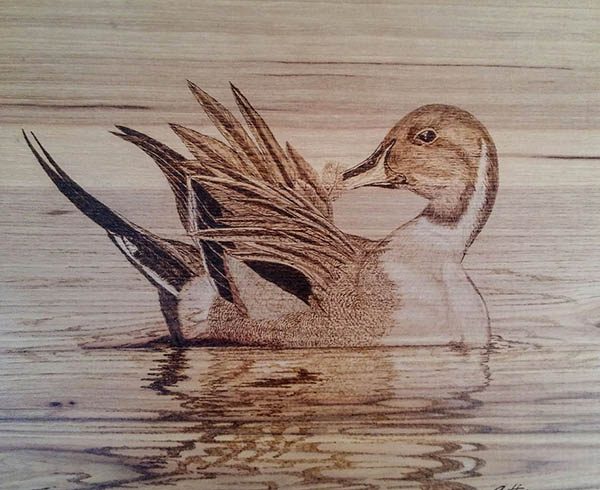
Although Scott Hirschi has always been artistically inclined, his introduction to woodburning, his current medium, came about by chance: “I just happened to come across a kit at an art store and I thought it looked interesting and started to do some pretty simple rudimentary stuff with it.”
A short while later, a friend who owned a better quality woodburner offered to let Scott use it, and he created a piece depicting a couple of Canadian geese swimming which was entered into a Ducks Unlimited live auction. “At that time, I was selling some drawings and stuff for maybe a couple hundred bucks, and this woodburned piece I did auctioned off for about $650. It kind of caught my attention, and I’ve been doing it ever since.”
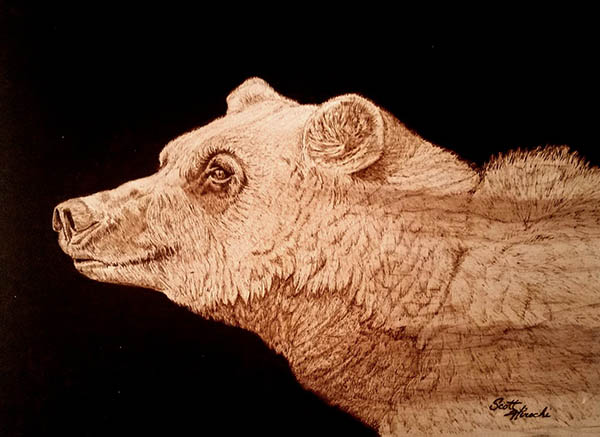
That was about 10 years ago; these days, Scott is getting his work into more galleries and art shows – including the Great Western Living & Design Exhibition in Great Falls, Montana, this March – while fighting the stigma sometimes attached to pyrography.
“People just have no idea pyrography can be this detailed, can be this realistic,” Scott said. “They have this image in their mind of the old woodburning kit when they were a kid, doing cartoon outlines and such. It’s kind of looked down upon by some people as a craft. I’m battling that every time I speak to a gallery owner, every time I try to explain that it’s not stencils.”
In fact, Scott’s work is “completely freehand. I draw everything.” With his subjects focused on animals and wildlife, Scott says he begins by drawing “a really rough sketch that’s only a few key components of the animal’s anatomy. Then I burn everything else. I don’t want it to look like a perfect photograph. I want an elk that I drew to look like an elk that I drew.”
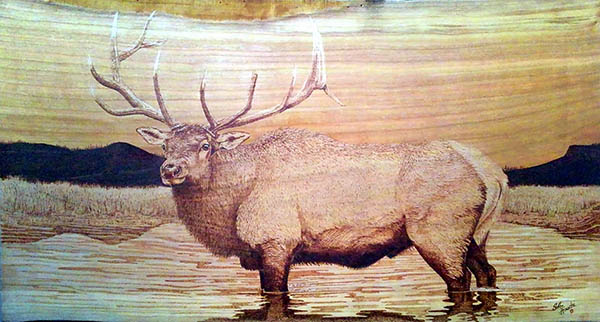
The elk is on Scott’s mind because it’s a piece that will be shown in public for the first time as part of the March show in Great Falls. A large piece – measuring 40 by 21 inches – the elk standing in water is burned onto cherry wood, the first piece of this species that Scott has worked with. “The cherry wood was perfect for it, and I plan on doing more on cherry wood in the future, because this piece was so much fun to do,” he said.
Part of the challenge of doing pyrography on different woods, Scott said, is that, “You don’t know how it’s going to burn until you try it. There’s different kinds of wood that are very good for burning, and there’s some kinds of wood that much more challenging. Some of them will nearly melt like wax. Some of them, you can’t get a lot of different tonal quality out of: they’re either burned or they’re not. There’s not a lot of darks and lights, and you can’t adjust the temperature to get different shades.”
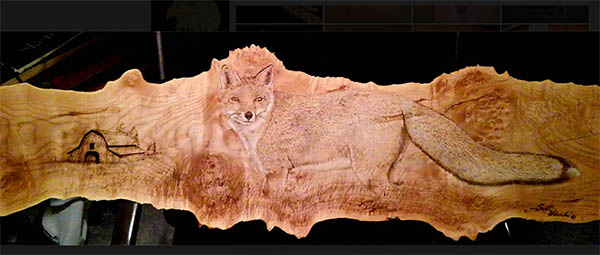
One of the best woods to burn on, Scott said, is basswood, but he likes to do larger pieces of artwork and has a challenge finding large pieces of basswood. He also enjoys working with maple in several forms, including bird’s eye maple burl and even maple plywood.
Scott has also done burnings on Russian olive – which, in Montana, is considered a noxious weed that ranchers want to get rid of – and on cedar. Both of those woods, Scott said, are beautiful, but a bit more challenging, due to the lack of tonal qualities after a burning.
To combat that, Scott will add some color to his works with watercolor pencils. “I try to be subtle with it. I don’t want it to look like a painting. I want somebody to look at it and know it’s been burned. If I overuse the color, it’s hard to tell it’s a burn at all.”
The use of color also depends on the subject of the artwork. “On the elk, it’ll just be the highlights of white on the antler tips, a little bit of white in the eyeballs – reflection of the eyes is very important in wildlife art,” Scott said. On the other hand, “A trout isn’t a trout until it has a little bit of color, so I will use the watercolor in some of those cases for actual color for the trout.”
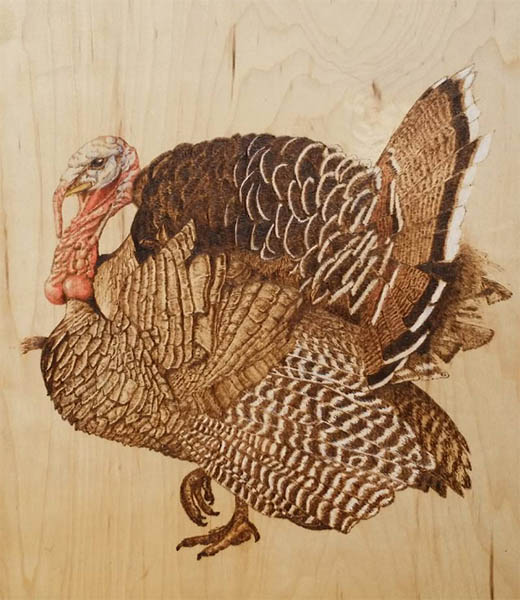
Plus, “I’ve got a piece on maple plywood that’s a tom turkey in full strut, and that turkey just didn’t look right until he had the red and blue on the head. It’s sort of a complement, yet it’s essential to the picture to bring that animal to life.”
Scott’s focus on animals draws on his personal interests, including hunting, fishing and photography, as well as the popularity of wildlife art in Western art. Ironically, although he’s always drawn animals – “When I was a kid, I drew a lot of deer and elk” – it wasn’t until he started pyrography that he started having success with birds. “For some reason; I’m able to pull of a lot more realism with a bird. It’s not even close.”
Scott has done some of his animal pyrography artwork from taxidermied models, but most of them, particularly fish, are done from reference photos. “I’ll look at lots of different photos and create my own drawing off of it,” Scott said.
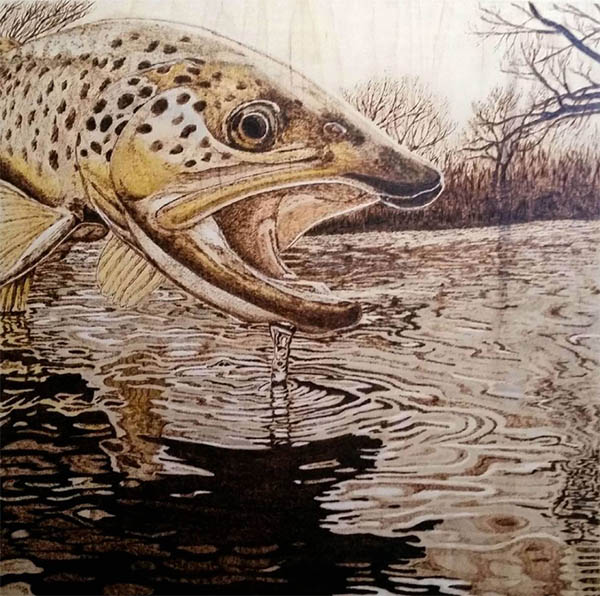
A couple of his fish pieces are significant in other ways, too. One called “Catch and Release” depicts a brown trout held above the water and, Scott said, was a big confidence booster. “When I first did it, the image that I had in mind I thought was really intimidating, so to be able to do that and have it turn out as well as it did was a big step forward.”

He’s also done a fish piece on a five-foot section of Russian olive. “I had this very long very rough, very natural piece of Russian olive at my house. I looked at it for probably six months and had no idea what I was going to do with it. And then one day, I was looking at it, and in the grain, there were four very distinct shapes that looked like fish, and so I turned that into four trout. When it hit me what those were, and that they were right there in the wood the whole time, it was kind of exciting.”
Scott attributes much of his success to mentoring from other woodworkers, such as sculptor Tom Dean, particularly in the area of learning about wood finishing. “I’m learning which finishes add a little gloss to it. In some cases, that’s desirable, and in other cases, it’s not. As I go and figure these things out, I’m learning how to to use them to make the artwork better.” He has sometimes used water-based spar urethane as a finish, but that can darken the grain or, sometimes, make the artwork look washed out.
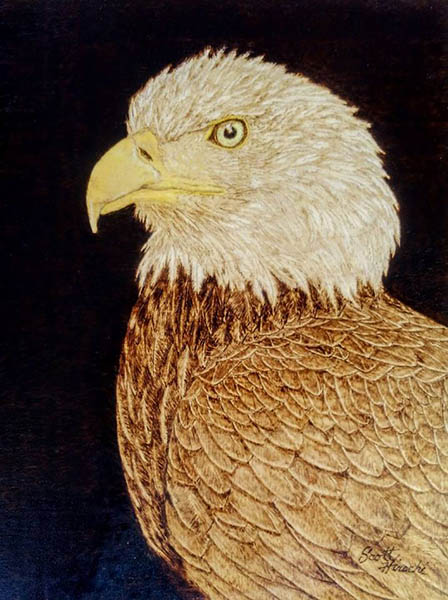
One successful experiment was partially finishing the elk piece with tung oil. “I knew when I finished it, the grain was going to come out really strong, so what I did is, I finished the sky in tung oil and then did not use the tung oil on the elk and the reflection of the sky in the water. It was a mirror image, but it wasn’t the same tone, so you could see the difference between the water and the sky.”
Eventually, Scott hopes to make his woodburning art his primary source of income. (Right now, his day job is as the morning host on a country music radio station.) “I’m progressing all the time, learning different things about different kinds of wood. And my burning has definitely increased in quality. It’s been a lot of fun and educational, and I’m starting to really produce stuff that a lot of people are really enjoying,” he said.





